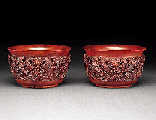 As we all know, elephants play a fundamental role in maintaining biological diversity and shaping a healthy bush environment and rhinoceroses are also an endangered species. To protect endangered species, the Convention on International Trade in Endangered Species (CITES) has triggered a global ban on the related trade. And, China has also gone on the record against illegal trading of endangered species.
As we all know, elephants play a fundamental role in maintaining biological diversity and shaping a healthy bush environment and rhinoceroses are also an endangered species. To protect endangered species, the Convention on International Trade in Endangered Species (CITES) has triggered a global ban on the related trade. And, China has also gone on the record against illegal trading of endangered species.
In this concern, tooth and horn carving is no longer practiced in China nowadays. However, related artworks passed down from the history still held an important position among Chinese traditional crafts, and the techniques used are also employed to make other handicrafts.
 Collection and maintenance
Collection and maintenance
Tooth and horn carvings are made from organic substances and are thus very delicate. Besides being fragile to the damage caused by external causes the artworks are also sensitive to temperature, humidity and illumination. Changes of temperature will make the artworks expand or contract, resulting in distortion, cracking and peeling. Unstable humidity will make them either lose or absorb water, resulting into expansion or contraction. It is better to place ornaments made of tooth and horn carving in a relatively humid environment, because dryness may result in cracking while too much humidity will cause mildew. Generally speaking, tooth and horn carvings stay good in temperature between 15 to 25 degrees and humidity levels of between 55% and 65%. Effected by light, teeth and horns are prone to chemical changes, and so their carvings should be kept in the shade.
 If mildew appears on the surface of tooth and horn carvings due to improper maintenance, it needs to be removed immediately. Usually, washing these articles in diluted citric acid or weak oxalic acid is effective, otherwise diluted ammonia can neutralize residual acid. Finally the artifacts should be cleaned in distilled water, dry them gently with a piece of clean cloth and air them in the shade. Dusts and feculences will make tooth and horn carvings age and metamorphose, so it is necessary to wipe them often and keep the articles clean. Tooth and horn carvings with cracking should not be washed in water, but dry cleaning with soap containing 1% white spirit or Trichloro ethane solution is effective. After the solution volatilizes, use a solvent to wipe off the residual soap on the surface and then wax polish and burnish the articles.
If mildew appears on the surface of tooth and horn carvings due to improper maintenance, it needs to be removed immediately. Usually, washing these articles in diluted citric acid or weak oxalic acid is effective, otherwise diluted ammonia can neutralize residual acid. Finally the artifacts should be cleaned in distilled water, dry them gently with a piece of clean cloth and air them in the shade. Dusts and feculences will make tooth and horn carvings age and metamorphose, so it is necessary to wipe them often and keep the articles clean. Tooth and horn carvings with cracking should not be washed in water, but dry cleaning with soap containing 1% white spirit or Trichloro ethane solution is effective. After the solution volatilizes, use a solvent to wipe off the residual soap on the surface and then wax polish and burnish the articles.
